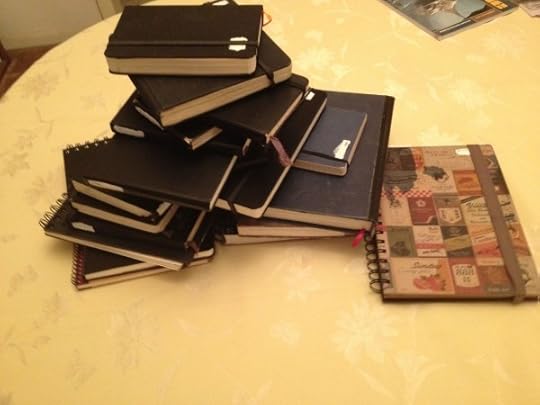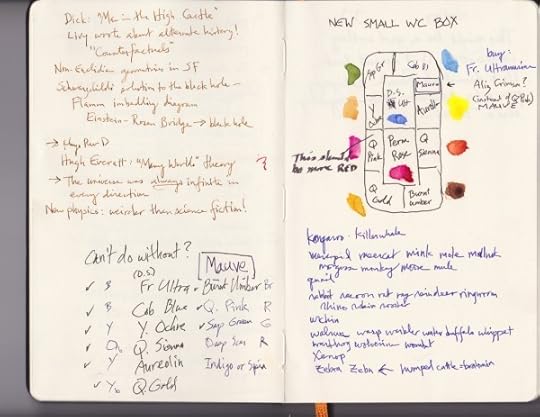notebooks
I think I got the Moleskine habit in 1989. I was noodling around the web and in a site dedicated to crossword puzzles, I found a reference to Moleskine notebooks. Tracked that down and found a strange and dedicated fandom.
I've been carrying little notebooks since I began carrying a purse in the sixties, but I was never systematic about it until I read that Moleskine blog. Why not? So I started carrying Moleskines, and eventually dedicated a foot or so of bookshelf space to them. They were a random mess, always falling down and put back any which way, so last week I got together all that I could find – nineteen of them – and dated them in a systematic way. A white gouache spot on the upper left front cover.

I have a couple of dozen other (larger) notebooks full of writing; for many years that's been the first stage of any serious piece of fiction. But this pile of Moleskines is a chronological miscellanea. A lot of notes about the books I'm working on. Lots of unrelated lecture notes and research. Pages of equations and library work.
Probably kind of rare. Most writers use computers for this kind of thing nowadays, and I do have megabytes of that stuff. But a fountain pen on paper is more real and more pleasing – and longer-lasting, I think. I've never had a page of handwriting disappear at the wrong stroke of a key.
Most of my notebooks are authentic Moleskines, though a half-dozen are other brands. I pronounce it "mole-ess-ki-nee," so it doesn't sound like some poor little blind creature was harvested for its manufacture. The company that makes them says there's no "official" pronunciation.
I've written two novels completely in Moleskines, Marsbound and Listen to the Raven (retitled The Coming at the editor's request). Carrying a large one around for months does tax its durability, especially if you bike everywhere. The elastic band helps to keep the book together, and of course keeps the book from opening up in your purse. Still, a couple of mine have gotten pretty shabby before the books were done.

This is my current one, a 5" X 8" hand•book, a brand that's not as well known as Moleskine. I've come to prefer them because their paper is slightly better for watercolor and fountain pen ink. Absorbent without being too absorbent. They look about the same, elastic band, black cloth cover with rounded corners.
The blank book I'm using for the current novel is a high-class leatherbound number I bought from a craftswoman in London. I forget how much it cost – less than a hundred pounds – but when I saw it I knew I had to turn it into a book. That could be a drawback, because it looks valuable and steal-able. A chance you take for the pleasure of using it, I guess.
Joe
I've been carrying little notebooks since I began carrying a purse in the sixties, but I was never systematic about it until I read that Moleskine blog. Why not? So I started carrying Moleskines, and eventually dedicated a foot or so of bookshelf space to them. They were a random mess, always falling down and put back any which way, so last week I got together all that I could find – nineteen of them – and dated them in a systematic way. A white gouache spot on the upper left front cover.

I have a couple of dozen other (larger) notebooks full of writing; for many years that's been the first stage of any serious piece of fiction. But this pile of Moleskines is a chronological miscellanea. A lot of notes about the books I'm working on. Lots of unrelated lecture notes and research. Pages of equations and library work.
Probably kind of rare. Most writers use computers for this kind of thing nowadays, and I do have megabytes of that stuff. But a fountain pen on paper is more real and more pleasing – and longer-lasting, I think. I've never had a page of handwriting disappear at the wrong stroke of a key.
Most of my notebooks are authentic Moleskines, though a half-dozen are other brands. I pronounce it "mole-ess-ki-nee," so it doesn't sound like some poor little blind creature was harvested for its manufacture. The company that makes them says there's no "official" pronunciation.
I've written two novels completely in Moleskines, Marsbound and Listen to the Raven (retitled The Coming at the editor's request). Carrying a large one around for months does tax its durability, especially if you bike everywhere. The elastic band helps to keep the book together, and of course keeps the book from opening up in your purse. Still, a couple of mine have gotten pretty shabby before the books were done.

This is my current one, a 5" X 8" hand•book, a brand that's not as well known as Moleskine. I've come to prefer them because their paper is slightly better for watercolor and fountain pen ink. Absorbent without being too absorbent. They look about the same, elastic band, black cloth cover with rounded corners.
The blank book I'm using for the current novel is a high-class leatherbound number I bought from a craftswoman in London. I forget how much it cost – less than a hundred pounds – but when I saw it I knew I had to turn it into a book. That could be a drawback, because it looks valuable and steal-able. A chance you take for the pleasure of using it, I guess.
Joe
Published on March 28, 2014 08:54
No comments have been added yet.
Joe Haldeman's Blog
- Joe Haldeman's profile
- 2191 followers
Joe Haldeman isn't a Goodreads Author
(yet),
but they
do have a blog,
so here are some recent posts imported from
their feed.



